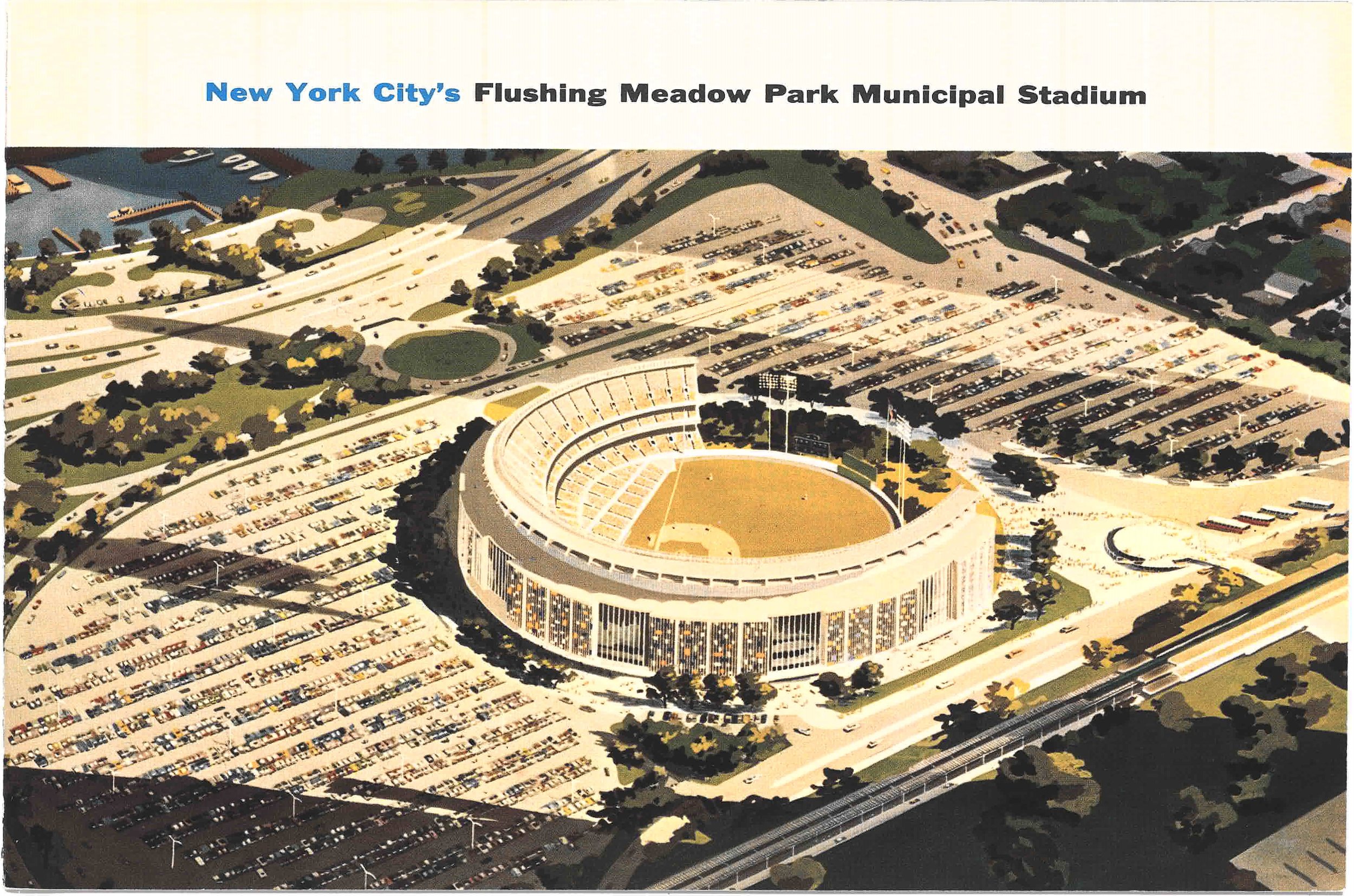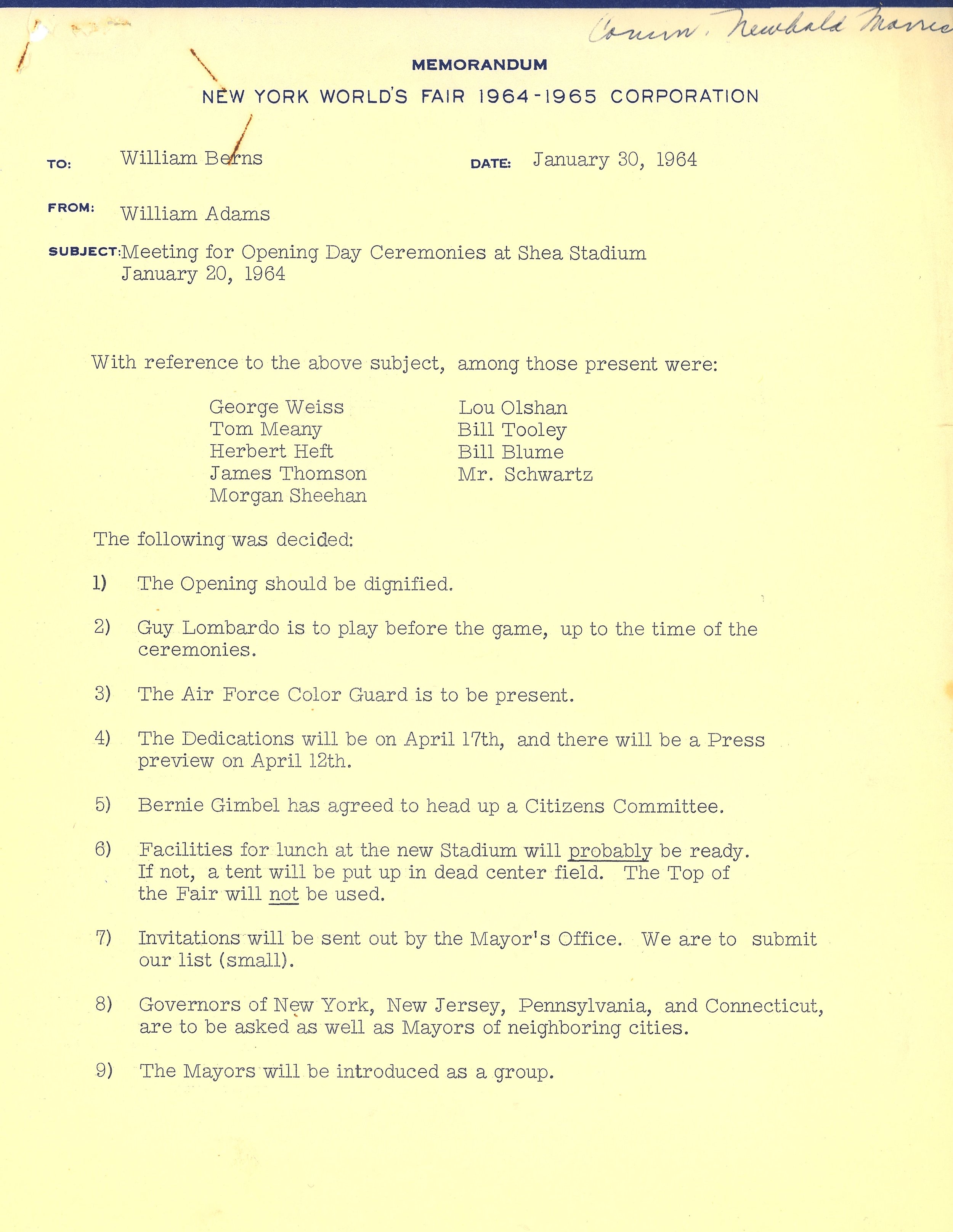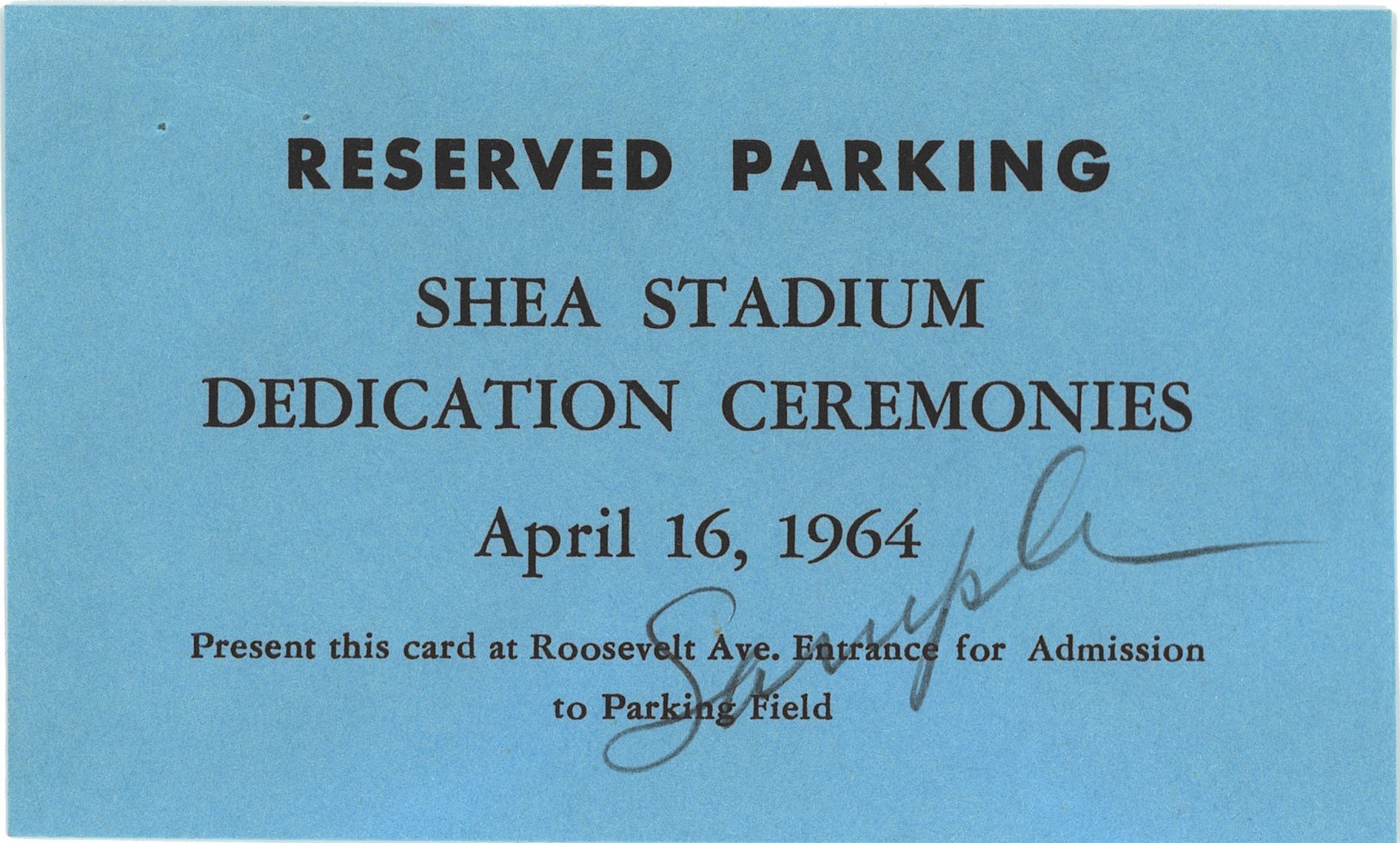On April 8, 1964, Robert Moses, then President of the New York World’s Fair Corporation, received an invitation to the upcoming dedication of Shea Stadium from City Parks Commissioner Newbold Morris. In his usual direct fashion Moses replied: “Many thanks. We shall all be there.”
Flushing Meadow Municipal Stadium, Brochure, 1963. Department of Parks General Files, NYC Municipal Archives.
In 1962, the National League had awarded one of two new teams franchised that year to New York City as a replacement for the Dodgers and Giants following their defection to California in 1958. Known as the New York Mets, the team played their first two seasons at the Polo Grounds. Shea stadium would serve as their home for the next forty-four years.
Invitation, 1964. Department of Parks General Files, NYC Municipal Archives.
This week, For the Record highlights Municipal Archives and Municipal Library collections that document the Shea Stadium dedication ceremony sixty years ago, on April 16, 1964.
Thanks to the City’s mayor-centric form of government, the first stop in the quest for information, especially on 20th century topics, is the mayor’s records. Comprehensive in scope and well-described, the mayoral record collections date from the mid-19th century to the present. Construction and dedication of Shea Stadium took place during Mayor Wagner’s term in office (1954-1965).
Reviewing the inventory of records from Wagner’s Department of Commerce and Public Events office revealed just one folder labeled “Shea Stadium.” The reason for the relative paucity of data in this series became clear in a memorandum from the file dated February 18, 1964: “Because Shea Stadium is Park Department property, the entire dedication ceremony, including the invitations and souvenir program, is being handled by [Parks] Commissioner Newbold Morris and his staff.” (Louis Olshan to Ambassador Richard Patterson, Commissioner, Department of Commerce and Public events.)
Like the mayor’s papers, the Archives’ collection of Parks Department records, particularly during the era of Commissioner Robert Moses, are comprehensive and well-described. Even though Moses had resigned from his post as Parks Commissioner in 1960 to plan the New York World’s Fair of 1964-65, Parks Department record-keepers continued their meticulous work through the 1960s. As cited in For the Record From the Dank Recesses--The Department of Parks General Files Parks series have served a wide range of research topics.
Shea Stadium and parking fields, photograph, n.d. Department of Parks General Files, NYC Municipal Archives.
Searching the Department of Parks General Series in 1964 resulted in a thick folder labeled Shea Stadium. The contents provided detailed information about work needed to complete the stadium in time for the opening, as well as ceremony planning details. According to a memorandum, dated January 30, 1964, “The Opening should be dignified.” It is not clear why this sentiment needed to be stated. Other decisions delineated in the document include, “Guy Lombardo is to play before the game,” and the “National Anthem to be sung by Robert Merrill.”
Memorandum, January 30, 1964, William Adams to William Berns, Subject: Meeting for Opening Day Ceremonies at Shea Stadium. Department of Parks General Files. NYC Municipal Archives.
Another mayoral series, the newspaper clipping scrapbooks, also proved to be informative. The scrapbook series date to 1895 and continue to the administration of Ed Koch. During their heyday—the mayoralties of LaGuardia through Beame—their thoroughness and utility are superlative.
Shea Stadium - New 1964 Home of the New York Mets, excerpt from brochure, 1964. Vertical File, Municipal Library.
Let’s Go Mets Pamphlet, 1964. Mayor Wagner Office of Commerce and Public Events. NYC Municipal Archives.
With the advent of easily searchable digitized media, researchers may be tempted to skip examining the scrapbooks, only accessible via cumbersome microfilm or hefty volumes. This would be a mistake. The search for Shea Stadium news articles is a good example. Scrolling through the microfilmed scrapbook of April 1964 news articles, researchers will not be surprised by the many stories on the new stadium and the upcoming World’s Fair opening. But what may not be expected are the numerous articles about a “Stall-In” orchestrated by the Congress of Racial Equality (CORE). Planned to take place on World’s Fair opening day, CORE announced that hundreds of drivers would travel on the highways leading to the fairgrounds and deliberately stall-out their automobiles to cause massive traffic jams. The purpose was to draw attention to discrimination and racism at the Fair. Based on the reporting, City officials can only be described as “freaked-out” by the prospect of this disruption to the big event. Researchers interested in how this story played out are welcome to visit the Municipal Archives and read through Mayor Wagner’s scrapbooks.
The Municipal Library’s vertical files are another reliable source of information about all aspects of the city and its government. Although the Shea Stadium vertical file lacks news clippings from the 1960s, it does contain an excerpt from The Municipal Engineers Journal, Fourth Quarterly Issue, 1963. Written by Richard Q. Praeger, partner in Praeger-Kavanagh-Waterbury, Consulting Engineers, the paper provides a very thorough and detailed history of how the stadium came into being.
The narrative starts by stating “. . . to attract Major League baseball back to New York it would be necessary to build a modern sports stadium with good parking facilities, centrally located and accessible . . . The lack of such a facility had been the major excuse used by the Giants and Dodgers for the move to the West Coast.” Construction on the new stadium began in November 1961, and was substantially completed by the dedication ceremony in 1964—lightening speed for municipal construction projects.
Reserved Parking Placard, 1964. Department of Parks General Files. NYC Municipal Archives.
Although Mayor Wagner’s Public Events office had relinquished planning the dedication ceremony to Parks, they retained responsibility for developing the guest list. Their file includes several pages of potential invitees—the usual city officials, plus major league baseball team owners and other prominent citizens. On one list, however, a staffer scribbled, “What about women?”
The day after the dedication ceremony, the Mets took to the field for their home-opener against the Pittsburg Pirates. Fate was not with them that day and they lost 4 to 3. But according to the Times report on the next day, fans loved Shea Stadium: “Fabulous Stadium Delights Fans.” The story sub-head continued: “Gleaming Ball Park Widely Acclaimed as Out of This World.” (The New York Times, April 18, 1964.)
Shea Stadium lasted as the Mets home until 2008 when it was dismantled. The site is now part of the parking lot of the new Citi Field.






